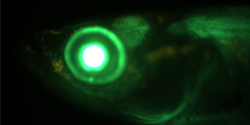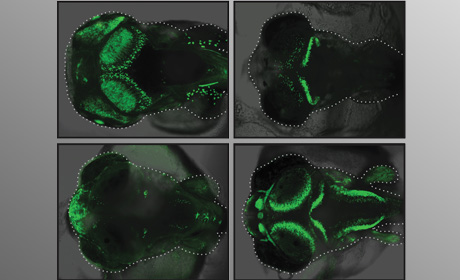“Junk DNA“ May Give Rise to Evolutionary Innovation
30 October 2011


Images: Etwiller / Eichenlaub
The vast majority of the human genome consists of DNA without any apparent function, so-called “junk DNA”. A study conducted by the scientists Dr. Laurence Ettwiller and Michael Eichenlaub at Heidelberg University's Centre for Organismal Studies now highlights this “dark matter” of the genome as a resource for evolutionary novelty. The scientists found that even small changes in functionally inactive “junk DNA“ are sufficient to create essential control elements in gene regulation known as enhancers. The results of the study will be published on 1 November 2011 in “PLoS Biology”.
Genetic variation in humans is not primarily due to differences in the 1.5 percent of DNA that code for gene products. Rather, experts today assume that most differences between humans are the result of changes in those DNA sequences that control gene regulation, i.e. the formation of gene products such as proteins. Enhancers are an essential component in the control mechanism of gene regulation. Changes in enhancers can lead to disease and malformation; on the other hand, they carry the potential for evolutionary innovation.
Michael Eichenlaub and Laurence Ettwiller have shown that such innovation can occur through “de novo” formation of new enhancers, arising from slight changes in the DNA that had no regulatory activity before. This finding contrasts with the general view amongst evolutionary scientists that novelty mainly arises from modification of pre-existing functional components of the genome. This view has generally led scientists to focus their attention on the loss and modification of functional elements, neglecting variations in the “junk DNA“, which makes up about 97 percent of genetic information. “This work brings such neglected regions of the genome to the forefront as a putative ‘breeding ground‘ for new enhancers“, says Laurence Ettwiller, who headed the study.

Images: Etwiller / Eichenlaub
To prove the existence of those new enhancers, the Heidelberg scientists designed an assay in the Japanese freshwater fish Medaka to capture rare events in which the sequence of a novel enhancer could be traced to other related species and validated these sequences experimentally. In several cases, they found evidence of a “de novo“ formation of new enhancers. “Even though this study has been conducted in fish, the same mechanisms apply to the human genome”, says Dr. Ettwiller.
“The study demonstrates that the slow but persistent changes that occur in DNA in each generation are sufficient to eventually lead to the apparition of new functions”, explains Michael Eichenlaub. “The methods we have established here could help to identify the changes that have contributed to the evolution of our species and explain the 1.23 percent of the genetic information that differ between the chimp’s and our genomes”, adds Dr. Ettwiller.
For more information, visit www.cos.uni-heidelberg.de/forschung/ettwiller/index.html .
Original publication:
Eichenlaub MP, Ettwiller L: De Novo Genesis of Enhancers in Vertebrates. PLoS Biol 9(11): e1001188. doi:10.1371/journal.pbio.1001188
Note for news desks:
Digital pictures are available from the Press Office.
Contact:
Dr. Laurence Ettwiller
Centre for Organismal Studies
Phone +49 6221 546495
laurence.ettwiller@cos.uni-heidelberg.de
Communications and Marketing
Press Office
Phone: +49 6221 542311
presse@rektorat.uni-heidelberg.de

